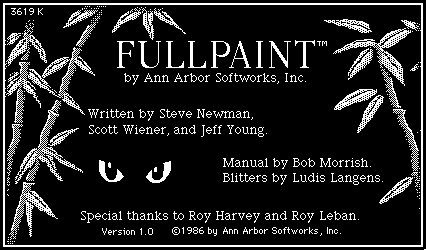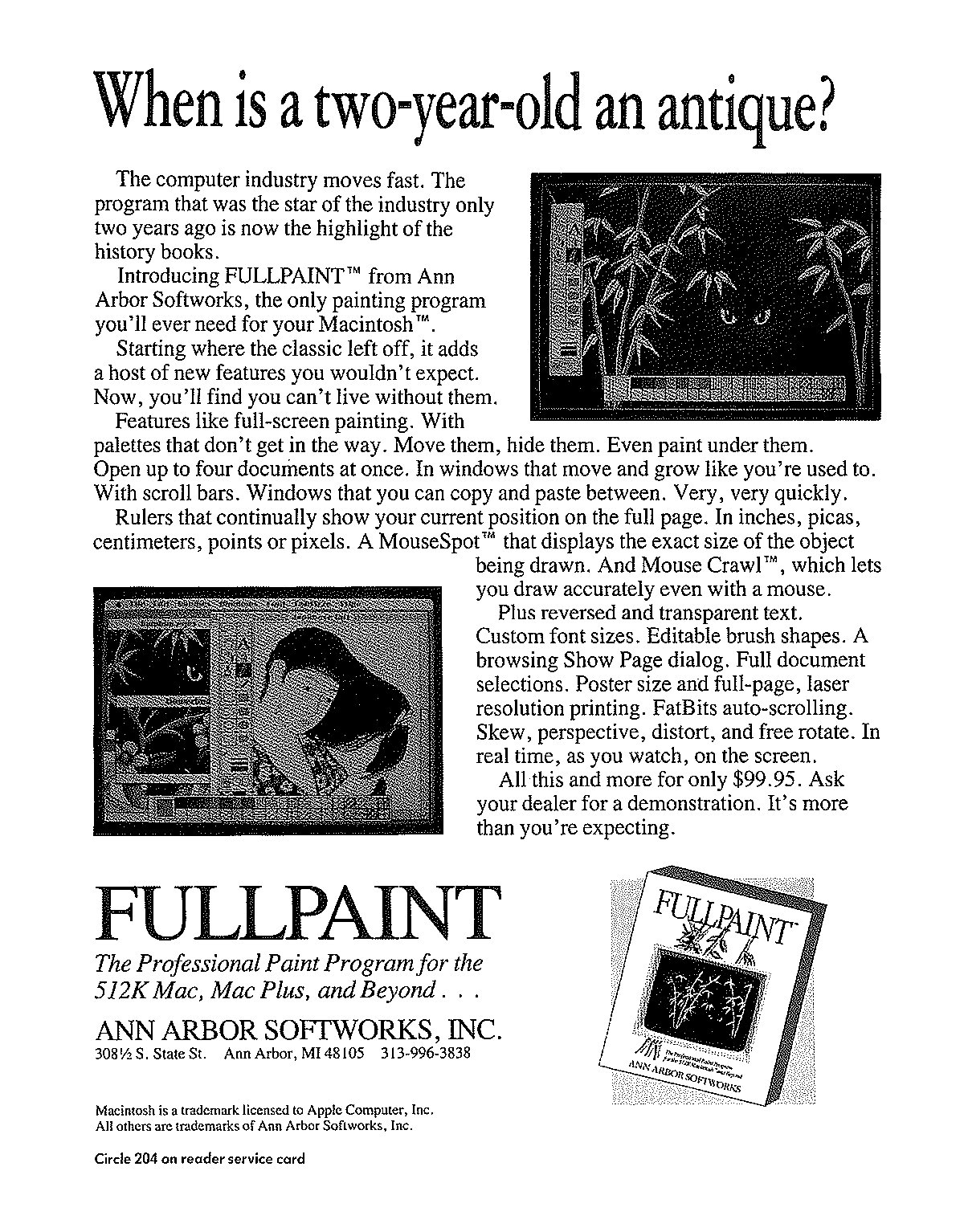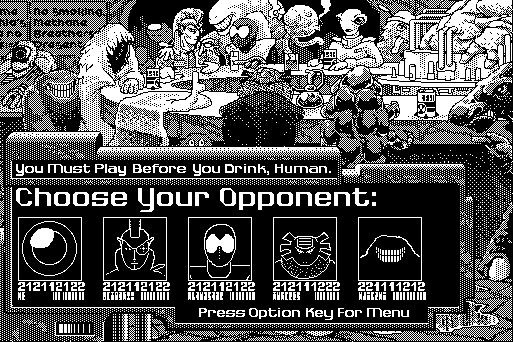FullPaint
1,519 words
15K on disk
May 1986
 FullPaint
FullPaint
Graphics Program

With the introduction of the Macintosh Plus in January 1986, Apple de-bundled MacPaint from its newer, more-capable and higher-priced computer offering. This created a natural opportunity for third-party vendors to write programs that more fully exploited the potential of the Plus’s high RAM and storage capabilities — and didn’t have to compete with free. Ann Arbor Softworks sprung into the market gap with FullPaint, and the influential computer aesthetics journal Verbum declared that “[t]he second wave of personal computer graphics tools came in with a resounding crash when FullPaint was released.”
Macworld Expo Boston, held in August, was the public debut of the program. A full review arrived in September 1986, with Macworld’s Robert C. Eckhardt declaring Ann Arbor Softwork’s program to be the first fully-featured competitor to MacPaint — and a “significant improvement” to it. A feature as simple as multiple windows was enough to expose potential hiding in the idea of MacPaint, which was still limited to one, non-resizable canvas. But FullPaint also implemented an idea so good it’s still present in Photoshop today: a three-stage toggle for traditional windows, fullscreen-with-menubar/palettes, and completely fullscreen modes:

FullPaint’s Free Rotate, Perspective, Distort and Skew features are another aspect called out in the 1986 MacWorld review that will resonate to users of Photoshop: “FullPaint,” as graphics guru Deke McClelland would later write, “introduced these commands.”
About the only complaint MacWorld had with the program was its RAM requirements, which placed limitations on its use with 512k Macs. The review concluded by making the point that FullPaint was an obvious buy to new purchasers of the Mac Plus who did not inherit a free copy of MacPaint from earlier hardware ownership — and who wanted software to put their new machine through its paces. By December of 86 the painting program had reached the Macworld best-seller list , where it would remain for seven months.
In the first Macworld issue of 1987, Adrian Mello was able to collect five programs to vie for the title of “MacPaint’s Successors” , comparing FullPaint along with CheapPaint, MacBillboard, GraphicWorks and SuperPaint. Mello saw FullPaint as the most direct descendent of the Mac’s original painting program, saying it “might just as well have been labeled MacPaint version 5.0”. (Interestingly, the version Mello tested in January of 1987 was labeled “1.0 Enhanced”, the main change in which was the removal of copy protection and the addition of a color printing utility.)
Indeed, in an issue where Macworld reviewed several large-screen monitors, FullPaint had already become part of the standard testing suite to determine how a paint program with multiple, resizable windows worked on emerging big-screen hardware. In addition, mentions of FullPaint in other companies’ advertisements also increased steadily. From ThunderScan to color-separation utilities to clip-art collections, many ads named FullPaint as an expected part of users’ workflows as an option alongside MacPaint. And when editor Jerry Borrell previewed the Macintosh SE in April, FullPaint was among the first programs he loaded to test how compatible the new machine was.
The idea of an upsell from the Mac’s bundled graphics program was enticing to mail-order vendors. “If you like MacPaint, you’ll love FullPaint” wrote The Icon Review in the April 1986 issue of MacWorld. “This stand-alone painting program is 100% upwardly compatible with MacPaint yet offers a host of exciting new features.” Ann Arbor Softworks itself worked to develop the notion of their product as the natural evolution of MacPaint, asking cheekily “When is a two-year-old an antique?” in an advertisement. “The program that was the star of the industry only two years ago is now the highlight of the history books.”

The writers of Macworld named Fullpaint an Editor’s Choice that same issue, and by August FullPaint had hit the rental software listings for $11.11. (See this piece by Blake Patterson for more on the oddball, time-limited niche of the “software rental” industry.
Yet the monochrome focus of FullPaint caused problems once the Mac II finally began shipping by the middle of 1987. Although the program apparently worked fine with third-party hardware vendor’s proprietary extensions to enable big-screen support, it was not re-written to support the emerging world of NuBus video cards. Left off the official Apple list of Mac II compatibility, the president of Ann Arbor Softworks himself confirmed that the program would only use the original 9″ screen size — and that his company had “no immediate plans” to offer a fix.
And by the end of 1986, SuperPaint had shipped — Silicon Beach Software’s ground-breaking app which fused object-oriented (MacDraw) and bit-mapped (MacPaint) illustration models into one program. MacWeek’s survey of graphics program during the first week of July 1987 showed FullPaint slightly behind SuperPaint in terms of percentage who owned a copy, but much less often used than SuperPaint (roughly 15% versus 5%.)
By the middle of July infamous rumor-monger Mac the Knife made note of the fading fortunes of Ann Arbor’s cash cow: “with SuperPaint on the market and Pixel Paint and maybe even MacPaint 2.0 on the horizon, the cow may be running dry.” In August, FullPaint dropped off the Macworld Best-Seller list for the first time in six months — with SuperPaint taking its place. By November of 1987 overviews of graphics software had placed FullPaint in a humble, if respected, niche as a “basic enhancement to MacPaint.”
It was arch-competitor Charlie Jackson, president of Silicon Beach, who would write perhaps the best epitaph:
FullPaint has been out since last May, and it had months of initially strong sales. It had good distribution and was a big step forward when it was released[…] About three months after SuperPaint came out, FullPaint sales began to decline. After about six months it reached its current level of negligible sales[…] SuperPaint has been outselling FullPaint 20 to 1.
On February 9th news broke that PC software giant Ashton-Tate would acquire FullPaint’s owner, Ann Arbor Softworks. But the focus was on the forthcoming FullWrite (Ann Arbor’s long-delayed word processor) and Full Impact, a spreadsheet written by Mac legend Randy Wiggington designed to go head-to-head with Microsoft Excel. Nobody predicted a big re-write for FullPaint, least of all Ashton Tate, who confirmed to Macworld that “the company is not upgrading the product.”
Perhaps the cruelest cut came from Adrian Mello’s review of MacPaint 2.0, where he noted “As offered, MacPaint [2.0] reminds me most of FullPaint, a program introduced two years ago that was quickly discarded by most people in favor of SuperPaint.” That Mello had to explain to his readers what FullPaint was speaks volumes. Pulling together a round-up of graphics programs the next month in the September issue, Mello was even more blunt:
“FullPaint is sorely in need of an update. When it was first introduced, it corrected most of the major deficiencies of the original MacPaint, but now it is showing its age. […] its windows cannot grow larger than the Plus’s or the SE’s screen. In its current form, FullPaint is probably not the best paint program for your needs. FullPaint used to serve as an option for users who weren’t satisfied with MacPaint[…] Well the classic is back[…] MacPaint [2.0] is a much better choice for beginners and users who prefer simplicity in paint software.”
David Pogue, writing a similar roundup in December 1989 but focusing exclusively on black & white bitmap apps, was kinder to FullPaint, calling it “inexpensive” and an heir to the “innocent charm” of the original MacPaint. In a book published in 1989, Deke McClelland echoed the notion of bang for the buck :
“The application was released in 1985, and has received very little attention since. We wouldn’t even bother to cover it except for two things. First, amazing as it may seem, it continues to offer features that the newest version of MacPaint lacks. And it’s cheaper than MacPaint.
FullPaint was listed in mail-order catalogs as late as December 1989, over three and a half years after launched. (This may be also testimony to the way that the 9″ monochrome monitor defined the user experience of most Mac users until the Fall 1990 introduction of the LC.) FullPaint still appears in the ad copy of other companies’ promotions in September 1992 as a commonly-used graphics program. And sometimes the last trace of a program is its removal – DublClick updated a clipart package in June of 1993 to change image format from FullPaint — back to MacPaint.
McClelland’s March 1992 round-up of painting programs — both greyscale and color — may represent the last mention of FullPaint in an editorial context, lumping it in with “programs you may have heard offer that you may even own, that have since fallen by the wayside.”
Sample Artwork
Two full-screen bitmap paintings shipped with FullPaint in 1986:




Information about FullPaint